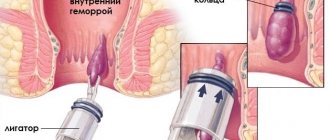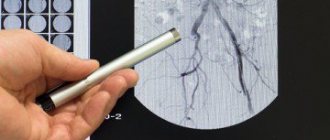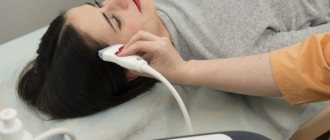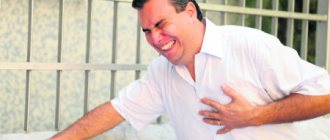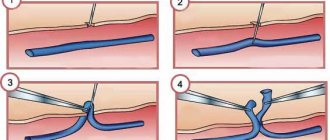© Author: Savelyeva Nadezhda Alekseevna, doctor of the therapeutic department, especially for SosudInfo.ru (about the authors)
A vena cava filter is a device installed in the lumen of the inferior vena cava (from the Latin cava - “hollow”), designed specifically to delay thromboembolism moving to the heart with the blood flow. Essentially, this is a sieve that freely allows blood to pass through and retains dense particles with a diameter of more than 2-4 mm.
What is a vena cava filter?
A vena cava filter is a high-tech mesh on a complexly modeled frame or other complex structure. Using X-ray vascular intervention, a vena cava filter is installed into the lumen of the inferior vena cava, just below the entry of the renal arteries into it (infrarenal position).
A vena cava filter installed in the inferior vena cava filters all particles larger than 2–4 mm (depending on design). This allows venous blood flow from the lower extremities and all internal organs to pass freely through the filter, while retaining large clots that could potentially lead to significant thrombosis or PE.
Under the influence of the blood anticoagulation system and anticoagulation drugs taken, for example, warfarin, stuck blood clots dissolve directly on the vena cava filter. If the filter is installed correctly, there is no need for repeated intervention. Modern designs of vena cava filters rarely thrombose.
What is a device
Structurally, the filter is represented by a curved metal wire and resembles a bird's nest, umbrella spokes, and flower petals. The main characteristics of high-quality implants:
- resistance to destruction,
- tight fixation,
- should not interfere with blood flow,
- delay of large blood clots,
- easy installation and removal if necessary.
To do this, use steel, titanium or an alloy with nickel, and cover parts of the vena cava filters with a membrane that is saturated with Heparin.
The size is selected depending on the individual diameter of the vein chosen for installation. A catheter is used for delivery to the implantation area.
After it has reached the desired location, the structure opens and fixes itself due to elasticity or “tendrils.” Such filters are firmly connected to the venous wall and are installed on a permanent basis. Removal will require complex surgery. If a temporary option is provided, the vena cava filter is equipped with a conductor attached under the patient’s skin. This thread is used to remove the device after use.
We recommend reading the article about blockage of blood vessels in the legs. From it you will learn about the causes of the pathology and its symptoms, the methods of diagnosis and treatment used.
And here is more information about the prevention of thrombophlebitis.
What vena cava filters are installed in the European clinic?
We use the most modern filter models, such as:
- permanent filter TrapEase (Cordis, USA),
- removable filters OptEase (Cordis, USA),
- Guenther Tulip (Cook, USA).
One of the latest innovations in the field of PE prevention is the ALN vena cava filter (ALN, France). This is the world's first vena cava filter that can be left in the vein for life or removed within up to 500 days. This is the longest possible removal period for removable vena cava filters.
The vena cava filter is securely fixed in the vessel wall under the influence of body temperature. The filter has radiopaque markers made of gold rings built into the catheter introducer, which allow you to easily track the movement of the vena cava filter through tortuous vessels. The two-level structure of the filter allows you to effectively capture emboli of various sizes without disturbing the blood flow.
The presence of a vena cava filter in the vena cava does not affect the operation of the magnetic resonance imaging scanner, so a patient with a filter can undergo an MRI examination if necessary.
When to choose temporary and when to choose permanent
Initially, it was assumed that the installed filters would be permanently in the vascular bed, and their removal was carried out only if serious complications developed. Since removable models have been developed, surgeons increasingly prefer their use.
Model of temporary vena cava filter 2014
Such a device can be installed for 2 - 3 months, that is, for as long as there is an increased risk of blood clots (for example, major surgery, trauma, heart valve replacement). After blood thinning has been achieved, or concomitant diseases have appeared that require removal of the filter, surgical removal of it from the vein can be performed.
Modern vena cava filters
If the period after implantation passes without complications, and the increased risk of blood clots in the deep venous network of the legs does not disappear, then the filter can be left.
How is a vena cava filter installed?
The procedure of implantation of a vena cava filter is currently a common endovascular intervention. The conductor with which the vena cava filter is implanted is inserted through the femoral access and the great saphenous vein, or into the jugular and subclavian veins under X-ray television control. The choice of access is determined by the intended location of the thrombus, since inserting a catheter through thrombosed veins is fraught with fragmentation of the thrombus with the development of pulmonary embolism. As a rule, the vena cava filter is installed at a level below the orifices of the renal veins.
Typically, the operation is performed in an X-ray operating room under short-term anesthesia (superficial anesthesia with propofol). During the implantation procedure, the patient does not feel any pain or discomfort.
Once the catheter reaches the desired level, the vena cava filter opens and the guidewire is removed. No stitches are placed on the skin. The duration of the placement procedure is usually about 1 hour. After implantation of the vena cava filter, a control x-ray is performed to confirm the correct installation and control its location.
We recommend limiting physical activity, preferably bed rest for 1–2 days after vena cava filter implantation. The patient is prescribed antibiotics and anticoagulants for 5–6 days.
Preparation for implantation
A doctor planning to implant a vena cava filter in a patient must know everything about his health: what medications he is taking, what he was sick with before, whether there was a history of allergies, etc.
Before installing the filter, the patient is prescribed the following tests:
- angiography;
- general urine and blood tests;
- blood biochemistry;
- coagulogram;
- Ultrasound of the kidneys;
- pregnancy test (for women).
Before surgery, your doctor may recommend stopping taking blood thinning medications (non-steroidal anti-inflammatory drugs, aspirin, anticoagulants, etc.). The patient should inform the doctor about the medications he is taking and the presence of allergic reactions (especially to local anesthetics and iodine-containing X-ray contrast agents).
The day before the operation, dinner should take place before 20.00. After midnight and in the morning you should not drink water or eat.
Before going to the operating room, the patient must remove all jewelry and other metal objects that can distort the results of the x-ray.
What are the indications for installing vena cava filters?
The generally accepted indications for the installation of vena cava filters are:
- Deep vein thrombosis of the lower extremities with the presence of non-occlusive (floating) thrombi - a permanent vena cava filter is installed.
- Deep vein thrombosis of the legs with concomitant atrial fibrillation, coronary heart disease, heart failure, as well as in patients with cancer, especially in the later stages.
- Episodes of pulmonary embolism (PE) in the past in the presence of venous thrombosis of the lower extremities at the present time - a permanent vena cava filter is installed.
- Carrying out operations on the veins, laparoscopic interventions for thrombosis of the pelvic veins. At the time of surgery and the immediate postoperative period, a temporary vena cava filter is installed.
The vena cava filter itself does not affect the risk of blood clots, since it does not eliminate the cause of the blood clots. However, it prevents pulmonary embolism from a detached thrombus and reduces the risk of sudden death.
At the European Clinic, we install more than 20 different types of vena cava filters for patients, both temporary and permanent, from the world's leading manufacturers.
Contraindications for thrombosis
As endovascular treatment technologies have advanced, insertion of a vena cava filter has become accepted as a routine method of preventing pulmonary embolism.
Despite this, anticoagulant therapy remains the main therapeutic factor for thrombosis, since it affects the cause of the disease, and surgery affects its consequences and complications.
In this case, contraindications to implantation may be identified:
- pathology of the inferior vena cava - excessive narrowing, inability to pass the catheter through nearby tissues and vessels, blockage above the renal segment;
- sepsis;
- malignant tumors;
- blood diseases.
In this regard, before referring the patient for the insertion of a vena cava filter, a complete angiographic examination is carried out to determine the patency of the vessels and select the required diameter of the device, and general clinical tests, ultrasound, and ECG are also prescribed.
What restrictions do patients face after installing a vena cava filter?
When installing universal removable vena cava filters, the patient is under the dynamic supervision of an angiosurgeon or phlebologist for 6 months. If a vena cava filter is installed, taking warfarin is mandatory.
Once the risk of thromboembolism has been reduced, the temporary vena cava filter is removed using an intervention similar to inserting a filter. This operation is also performed in an X-ray operating room by an angiosurgeon under X-ray control.
The fundamental decision to remove the vena cava filter is made after a repeat study of hemodynamics in the inferior vena cava system (including both limbs), when the dynamics of thrombosis resolution is assessed.
The installation of non-removable permanent vena cava filters, even in patients with advanced stages of cancer, is currently practiced relatively little, since a permanent vena cava filter, along with its positive role - preventing thromboembolism - causes obstruction of blood flow in the inferior vena cava basin and the formation of secondary venous insufficiency.
After installing a vena cava filter, the patient lives a normal life. We recommend taking indirect anticoagulants in maintenance dosages. In the presence of concomitant chronic venous insufficiency, it is advisable to undergo clinical observation with a visit to the doctor at least once a month, use phlebotonics and wear compression stockings. In addition, it is advisable to undergo a control duplex scan of the veins of the legs and the inferior vena cava.
After operation
In the first days, the patient must remain in bed. In addition, he is prescribed heparin and antibacterial agents. When puncturing the veins of the neck, the patient’s usual level of activity is allowed after 24 hours, when inserting a filter through the femoral vein - after 48 hours.
After installing the filter, the patient must inform the doctor if the following symptoms occur:
- fever;
- prolonged headache and nausea;
- discomfort and pain in the chest;
- numbness or coldness of the leg;
- bleeding, swelling, pain or redness at the vein puncture site.
What is the cost of installing a vena cava filter in Moscow?
We bring to your attention a price list from which you can find out the cost of installing vena cava filters in a European clinic:
- Implantation of a permanent vena cava filter made in the USA - 125,000 rubles.
- Implantation of a vena cava filter (made in the USA) with retrograde iliocavagraphy - 163,000 rub.
- Removal of a removable vena cava filter - RUB 106,900.
- Implantation of a removable vena cava filter made in the USA or France - 160,000 rubles.
Book a consultation 24 hours a day
+7+7+78
Our doctors
Konstantinova Galina Dmitrievna
Cardiovascular surgeon, phlebologist, Doctor of Medical Sciences, Professor
Make an appointment
Drozdov Sergey Alexandrovich
Cardiovascular surgeon, phlebologist, Doctor of Medical Sciences
Experience 46 years
Make an appointment
Malakhov Yuri Stanislavovich
Doctor - cardiovascular surgeon, phlebologist, Honored Doctor of the Russian Federation, Doctor of Medical Sciences, doctor of the highest category
35 years of experience
Make an appointment
How is the postoperative period going?
As soon as the procedure is completed, the patient wakes up in the operating room. Doctors need to assess the patient’s general condition and check reflex activity. He is then transferred to the general ward. You are allowed to stand on your feet once and no earlier than 5-6 hours from the moment of awakening. On the first day, eating is prohibited; you can only drink still water.
Within a week, the suture material is treated with an antiseptic. The threads are removed after 7-10 days. If the patient suffers from pain in the stomach or back, the doctor prescribes symptomatic treatment - short-term use of NSAIDs. When the general condition normalizes, the patient is discharged home. Typically, hospital stay lasts no more than 5 days, unless any deterioration occurs.
For a month after discharge, a special diet is prescribed that excludes the consumption of very fatty meat, fried foods, dairy products and eggs. At the same time, it is forbidden to train intensively in the gym and exhaust yourself with physical labor.
Laparoscopy is done for diagnostic and therapeutic purposes. The minimally invasive method is more acceptable for many, as it is less likely to cause complications compared to abdominal surgery. The latest technical developments minimize the risks to the patient’s life, so the procedure is being performed more and more often. To learn more about the treatment method, it is recommended to study other topical articles on the site.
Removing a fixture
If the vena cava filter was initially installed as a temporary filter, then its removal is carried out by pulling on the conductor fixed under the skin.
If it is necessary to remove a permanent device, a catheter with a hook at the end is passed through the femoral vein. They grip the filter and then slide a cannula over it to cover its parts. After this, folded, it is removed from the vein. All these actions are carried out under intravenous anesthesia and visual control using ultrasound or radiography.
Device for removing the vena cava filter
Device installation
Installing a vena cava filter is a simple procedure. Thanks to high-tech equipment, implantation takes about sixty minutes.
There are different methods for introducing a vena cava filter, depending on the physiological characteristics of the body, as well as the patient’s health condition.
The access for installing a vena cava filter is selected in the thigh area. All this happens under the supervision of radiologists, who initially determine the possible location of the blood clot.
Before the installation procedure, the patient is given anesthesia. Typically, only superficial anesthesia is used. This relieves the patient of pain during implantation and other unpleasant sensations.
A special conductive device allows you to transport the vena cava filter to the required installation site. When the vena cava filter reaches this area, it opens on its own and is brought into working condition.
Then the conductive device is removed, after this procedure there will be no need for sutures or other procedures for the restoration process of the skin.
The vena cava filter, once in the cavity of the blood vessel, attaches to its wall, this is facilitated by the human body temperature. Vava filters have special markings that look like gold rings and allow the structure to be clearly visible on an X-ray machine.
The process of installing vena cava filters is possible even in curved and highly tortuous vessels. Their movement through the vessels is controlled using special rings that create contrasting reflections.
At the end of the procedure, additional x-rays are necessarily taken to verify the correct installation of the vena cava filter.
The patient is advised to refrain from strenuous sports activities, maintain rest and inactivity for 2-3 days after surgery. The patient takes antibiotics for a week and is observed by a doctor.
Possible complications
Large clinical centers have gained extensive experience in performing such operations, so installing a filter in a vessel practically does not cause complications. Rare early effects include:
- incorrect location - blocks the vein or is not attached to its wall;
- bleeding due to vessel injury;
- infection.
Prolonged presence of a foreign body in the venous system over time can provoke the following conditions:
- blockage of the inferior vena cava, renal, peripheral vein;
- pulmonary embolism;
- perforation of the venous wall;
- displacement of the filter into the heart cavity;
- destruction of the structure and separation of small parts - vascular embolism;
- formation of a hematoma, a focus of chronic infection.
